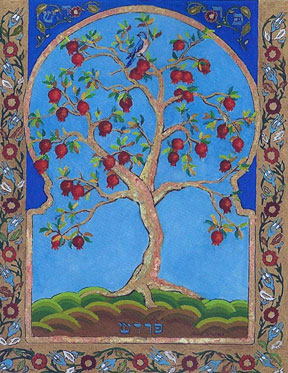![]()
Portals of Epiphany
by Fr. Dave Denny
 On September 14, Oregon artist Anne Barber-Shams' exhibition "Mihrab: Metaphorical Portal" opened at The Jerusalem Fund Gallery in Washington, D.C. and will run until October 26. Drawing inspiration from medieval Spain, where Jewish, Christian, and Muslim communities lived in relative peace and cultural cooperation, Barber-Shams' acrylic paintings include gold leaf and calligraphy, with a common design thread: each image is framed by a keyhole arch border representing both the arches of Spanish mosques and the mihrab, the niche that faces Mecca in every mosque.
On September 14, Oregon artist Anne Barber-Shams' exhibition "Mihrab: Metaphorical Portal" opened at The Jerusalem Fund Gallery in Washington, D.C. and will run until October 26. Drawing inspiration from medieval Spain, where Jewish, Christian, and Muslim communities lived in relative peace and cultural cooperation, Barber-Shams' acrylic paintings include gold leaf and calligraphy, with a common design thread: each image is framed by a keyhole arch border representing both the arches of Spanish mosques and the mihrab, the niche that faces Mecca in every mosque.
Barber-Shams understands the archway as a symbol of the threshold of revelation, a portal of epiphany, similar to the Holy of Holies or Tabernacle in Jewish and Christian traditions. In these paintings she draws on scriptural and historical images common to each of the Abrahamic traditions: Judaism, Christianity and Islam. By doing so, she hopes her art will promote healing between these communities, who, despite our history of conflict and bloodshed, share so much common ground
Interspersed with her icon-like paintings are marbleized mylar hangings including calligraphy "morsels" of poetry from medieval Spain, known to Muslim inhabitants as Al-Andalus. Pre-Islamic Mecca celebrated the greatest Arab poets by embroidering and hanging their odes on the Ka'aba. This tradition inspired Barber-Shams to include excerpts from Jewish, Christian, and Muslim poets of Al-Andalus.
Abd al-Rahman I, founder of the great Umayyad state in Al-Andalus, lay the groundwork for the Iberian Abrahamic culture that flourished in the Middle Ages. Anne Barber-Shams wrote to the Desert Foundation about Islam's approach to interfaith relationships:
"That era in Andalusia was a triumph of inclusion. I revised my booklet about the exhibit to include the following contract Mohammed made with the citizens of Medina, because an Arab woman encouraged me to give credit to Abd al-Rahman for setting the tone of that time, by following Mohammed's example when he established his reign.
Abd al-Rahman's establishment of Mohammed's definition of the Islamic ummah, or community, defined the era. In a document Mohammed negotiated with the early clans of Medina, Jewish, Christian and pagan citizens were explicitly referred to as members of the ummah with specific rights. Wikipedia dates the document at 622 AD:
- The security of God is equal for all groups.
- Non-Muslim members have equal political and cultural rights as Muslims. They will have autonomy and freedom of religion.
- Non-Muslims will take up arms against the enemy of the Ummah and share the cost of war. There is to be no treachery between the two.
- Non-Muslims will not be obliged to take part in religious wars of the Muslims.
Abd Al-Rahman's implementation of the ummah and his transfer to his new home of his heritage from the ancient mix of cultures in Damascus formed the policy of inclusion and assimilation that marked the era."
To see and hear Anne Barber-Shams describe her work, visit her Kickstarter page. Visit the Jerusalem Fund Gallery to learn more about her exhibit.